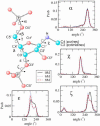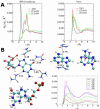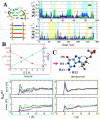Urea destabilizes RNA by forming stacking interactions and multiple hydrogen bonds with nucleic acid bases
- PMID: 19919063
- PMCID: PMC2791195
- DOI: 10.1021/ja905795v
Urea destabilizes RNA by forming stacking interactions and multiple hydrogen bonds with nucleic acid bases
Abstract
Urea titration of RNA by urea is an effective approach to investigate the forces stabilizing this biologically important molecule. We used all atom molecular dynamics simulations using two urea force fields and two RNA constructs to elucidate in atomic detail the destabilization mechanism of folded RNA in aqueous urea solutions. Urea denatures RNA by forming multiple hydrogen bonds with the RNA bases and has little influence on the phosphodiester backbone. Most significantly we discovered that urea engages in stacking interactions with the bases. We also estimate, for the first time, the m-value for RNA, which is a measure of the strength of urea-RNA interactions. Our work provides a conceptual understanding of the mechanism by which urea enhances RNA folding rates.
Figures




Similar articles
-
Dispersion interactions between urea and nucleobases contribute to the destabilization of RNA by urea in aqueous solution.J Phys Chem B. 2015 Mar 5;119(9):3755-61. doi: 10.1021/jp512414f. Epub 2015 Feb 23. J Phys Chem B. 2015. PMID: 25668757 Free PMC article.
-
Equilibrium Denaturation and Preferential Interactions of an RNA Tetraloop with Urea.J Phys Chem B. 2017 Apr 20;121(15):3734-3746. doi: 10.1021/acs.jpcb.6b10767. Epub 2017 Feb 16. J Phys Chem B. 2017. PMID: 28181434
-
Urea-induced denaturation of preQ1-riboswitch.J Am Chem Soc. 2013 Aug 14;135(32):12112-21. doi: 10.1021/ja406019s. Epub 2013 Jul 31. J Am Chem Soc. 2013. PMID: 23863126
-
Electronic properties, hydrogen bonding, stacking, and cation binding of DNA and RNA bases.Biopolymers. 2001-2002;61(1):3-31. doi: 10.1002/1097-0282(2001)61:1<3::AID-BIP10048>3.0.CO;2-4. Biopolymers. 2001. PMID: 11891626 Review.
-
Aromatic Base Stacking in DNA: From ab initio Calculations to Molecular Dynamics Simulations.J Biomol Struct Dyn. 2000;17 Suppl 1:1-24. doi: 10.1080/07391102.2000.10506597. J Biomol Struct Dyn. 2000. PMID: 22607400 Review.
Cited by
-
Directly lighting up RNA G-quadruplexes from test tubes to living human cells.Nucleic Acids Res. 2015 Nov 16;43(20):9575-86. doi: 10.1093/nar/gkv1040. Epub 2015 Oct 17. Nucleic Acids Res. 2015. PMID: 26476445 Free PMC article.
-
A Widely Applicable Urea-based Fluorescent/Colorimetric mRNA in situ Hybridization Protocol.Bio Protoc. 2019 Sep 5;9(17):e3360. doi: 10.21769/BioProtoc.3360. eCollection 2019 Sep 5. Bio Protoc. 2019. PMID: 33654858 Free PMC article.
-
Real-time monitoring of DNA G-quadruplexes in living cells with a small-molecule fluorescent probe.Nucleic Acids Res. 2018 Sep 6;46(15):7522-7532. doi: 10.1093/nar/gky665. Nucleic Acids Res. 2018. PMID: 30085206 Free PMC article.
-
Translocating kilobase RNA through the Staphylococcal α-hemolysin nanopore.Nano Lett. 2013 Jun 12;13(6):2500-5. doi: 10.1021/nl400560r. Epub 2013 May 23. Nano Lett. 2013. PMID: 23678965 Free PMC article.
-
Urea-aromatic interactions in biology.Biophys Rev. 2020 Feb;12(1):65-84. doi: 10.1007/s12551-020-00620-9. Epub 2020 Feb 17. Biophys Rev. 2020. PMID: 32067192 Free PMC article. Review.
References
-
- Fersht A. Structure and Mechanism in Protein Science: A Guide to Enzyme Catalysis and Protein Folding. W. H. Freeman Company; 1998.
- Tanford C. J. Am. Chem. Soc. 1964;86:2050–2059.
- Makhatadze GI, Privalov PL. J. Mol. Biol. 1992;226:491–505. - PubMed
- Myers JK, Pace CN, Scholtz JM. Protein Sci. 1995;4:2138–2148. - PMC - PubMed
-
- Pan J, Thirumalai D, Woodson SA. J. Mol. Biol. 1997;273:7–13. - PubMed
- Rook MS, Treiber DK, Williamson JR. Proc. Natl. Acad. Sci. 1998;281:609–620. - PubMed
- Shelton VM, Sosnick TR, Pan T. Biochemistry. 1999;38:16831–16839. - PubMed
- Sclavi B, Woodson SA, Sullivan M, Chance MR, Brenowitz M. J. Mol. Biol. 1997;266:144–159. - PubMed
-
- Robinson DR, Jencks WP. J. Am. Chem. Soc. 1965;87:2462–2469. - PubMed
- Wallqvist A, Covell DG, Thirumalai D. J. Am. Chem. Soc. 1998;120:427–428.
- Vanzi F, Madan B, Sharp K. J. Am. Chem. Soc. 1998;120:10748–10753.
- Tobi D, Elber R, Thirumalai D. Biopolymers. 2003;68:359–369. - PubMed
- Soper AK, Castner EW, Luzar A. Biophys. Chem. 2003;105:649–666. - PubMed
- Bennion BJ, Daggett V. Proc. Natl. Acad. Sci. 2003;100:5142–5147. - PMC - PubMed
- O'Brien EP, Dima RI, Brooks B, Thirumalai D. J. Am. Chem. Soc. 2007;129:7346–7353. - PubMed
- Hua L, Zhou R, Thirumalai D, Berne BJ. Proc. Natl. Acad. Sci. 2008;105:16928–16933. - PMC - PubMed
- England JR, Pande VS, Haran G. J. Chem. Soc. 2008;130:11854–11855. - PMC - PubMed
-
- Mason PE, Neilson GW, Enderby JE, Saboungi M-L, Dempsey CE, MacKerell AD, Brady JW. J. Am. Chem. Soc. 2004;126(11):462–11470. - PubMed
-
- Rudisser S, Tinoco I., Jr. J. Mol. Biol. 2000;295:1211–1223. - PubMed
Publication types
MeSH terms
Substances
Grants and funding
LinkOut - more resources
Full Text Sources

